Andrew Carrier, active underwriter at the Kiln syndicate at Lloyd's, highlighted the challenges facing the humble catastrophe line underwriter.
He said there are difficulties in using the past as a guide to the future, about the difficulty of measuring the scale of losses, even after they've occurred, and some of the demographic challenges in adjusting prices upwards.
Looking at the severity of some of the hurricanes that have struck the US mainland in the past 35 years he says: "The thing you notice is that the force four and five hurricanes, which are the ones that really cause the damage, have been fairly rare in the last 30 or 40 years."
But looking at the most recent five years, there has been a marked increase in the force five and force four hurricanes, which are taking place.
"As underwriters, we have to try and interpret this data and calculate whether this is a blip, whether it's part of a beginning of a new trend and actually adjust our prices on that," he says.
What the industry is facing today is that the capital base that underpins it is very sensitive.
"And whenever there is a hurricane out on the coast heading for the mainland, an underwriter's phone starts ringing and people start saying, 'how big is the loss going to be?'
"Now many years ago we always used to be able to say, it's too early to tell, and that, quite frankly, is often the only sensible and logical answer that one can give."
He adds that the industry is still in denial about the scale of the devastation caused by Hurricane Wilma. "Two thirds of the human race live on or within a 150 kilometres of a coastline, and considering the amount of land mass in the world, that really is a startling fact.
"We all know very much about the retiree communities in the southeast of America, with everyone wanting to live in the sunshine state, where population growth has been 75% in the last 25 years or so."
But he says it is the underlying trend here which is the biggest challenge for underwriters, and a brief outline of some of the challenges they face, produces more questions than answers.
"But I think that really is the market we're in today. The frequency and the severity data is becoming impossible to interpret. The losses themselves are a moving target, they just keep growing, and the population swings that we're looking at in some of the catastrophe exposed areas, are so severe, we as an industry just can't charge enough."
Hosted by comedian and actor Tom Allen, 34 Gold, 23 Silver and 22 Bronze awards were handed out across an amazing 34 categories recognising brilliance and innovation right across the breadth of UK general insurance.













































